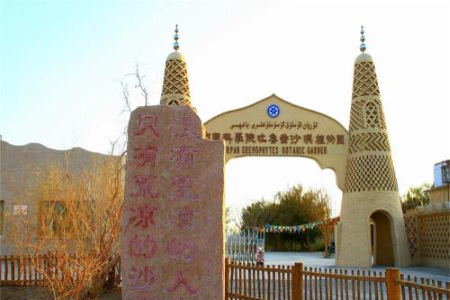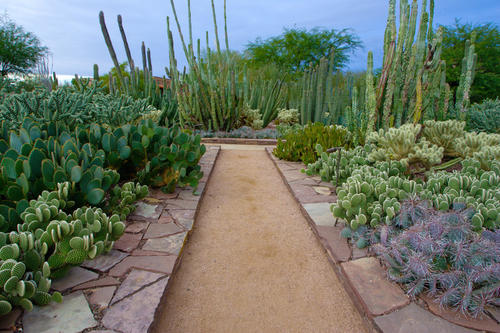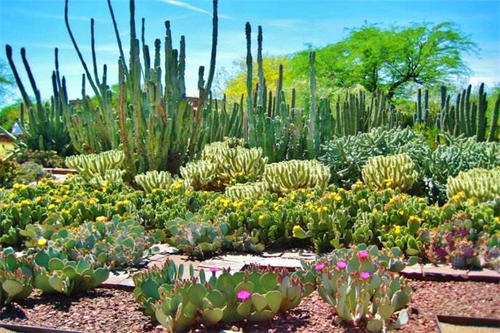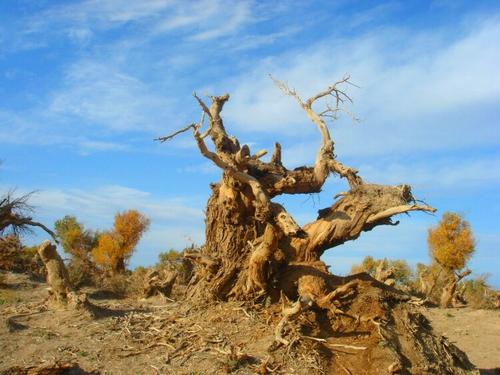Chinese Name: 吐鲁番沙漠植物园 Pronunciation: Tǔlǔfān Shāmò Zhíwùyuán
Building Time: 1976
Suggested Visiting Hours: 2-3 Hours
Function: Scientific research, education and tourism
Address: Qiatkale Town, Gaochang District, Turpan City, Xinjiang Autonomous Region, China
Best Visiting Time: The best tourist season for the Botanical Garden is from May to October.
The Turpan Eremophyte Botanical Garden is divided into South Garden and North Garden. The South Garden is mainly a sightseeing area while the North Garden is an exhibition area. The entrance of South Garden is 40 yuan per person. The Science Exhibition Hall in North Garden is free of charge.
| Content | South Garden |
| Opening Hours | 9: 00-20: 00 |
| Ticket Selling Time | 9: 00-19: 30 |
Opening Hours of Botanical Science Hall: 9: 00-18: 00 (Closed on Mondays, except statutory holidays)
It is temporarily closed for COVID-19.

Turpan Eremophyte Botanical Garden is affiliated with Xinjiang Institute of Ecology and Geography of Chinese Academy of Sciences. Its predecessor is Turpan Hongqi Sand Control Station, which was established in 1972. At the beginning of the construction of the station, this area was facing a severe desertification problem.
Under the guide of the People’s Government of Turpan, windbreaks and fences were established to effectively protect the soil from erosion. On this basis, more desert plants have been introduced and cultivated in the Turpan Eremophyte Botanical Garden. Located 11 kilometers southeast of Turpan City, the Botanical Garden now covers an area of 150 hectares.
With an altitude ranging from -76 meters to -105 meters, Turpan Basin ranks the second lowest land worldwide and the garden is situated on the improved shifting sand land in the hinterland of the basin. The mean annual precipitation is 16.4 mm; the annual amount of evaporation is 3000 mm; the annual average temperature is 13.9 ℃, and the extreme maximum temperature is 47.6 ℃. In the summer, the maximum temperature of sand surface will even exceed 80 ℃, thus giving the basin the name of “wind bank” and “fire continent”.
At present, Turpan Eremophyte Botanical Garden has become a reserve warehouse of desert plant resources (species and genes) in Central Asia, a research base for ex-situ conservation and sustainable utilization of desert plant diversity in China, and a national science education base.

More than 800 species of desert plants are preserved here, basically covering the main component groups of the Central Asian desert flora, which belong to 87 families and 385 genera. Among them, 43 species are rare plants in desert, 21 species are endemic, and 4 species are remnants.
According to the existing land layout and function, the Turpan Eremophyte Botanical Garden is divided into two parts: the North Garden and the South Garden. The South Garden covers an area of 145 hectares. Most of it is open to the public. It is the main area of the desert botanical garden and 10 special gardens, including Calligonum Germplasm Resource Nursery, Calligonum Mongolicum Special Garden, Tamarix Chinensis Special Garden, Ethnic Medicinal Botanical Garden, Desert Plant Living Specimen Garden, Halophyte Area, Haloxylon Bunge Plant Desert Landscape Area, Limonium Special Garden, Grass Garden and Mulberry Garden. Tourists could also find an automatic meteorological observation field, the artificial windbreak and sand fixation demonstration forest, and the Karez Well here.
The North Garden consists of a biological specimen hall, a laboratory building, a staff dormitory, an expert guest apartment, a science exhibition hall, a conference room, a restaurant, an iris special garden, an economic fruit tree garden in arid areas and a desert plant introduction experimental area, some of which are open to the public.

with a planting area of 1,200m2, the garden has collected 10 species of Limonium plants inside and outside Xinjiang, accounting for 81% of the total species of Limonium in Xinjiang.
Due to its persistent corolla, the flowers can survive and maintain its original color and pattern for a long time after blooming. It is very suitable for making handicrafts such as flower arrangements and dried flowers, which also adds a taste to the garden in winter days.

The Cash Crop Garden was established in 1995. The garden covers an area of 6,600m2 and is mainly composed of Rosaceae and Vitaceae. 39 species of cash crops and more than 30 kinds of grapes have been introduced into the arid desert area.
Tourists can enjoy the flowers and sceneries of all kinds of fruit trees planted in the garden in spring, and pick and taste different kinds of fruits in summer and autumn.

With about 60 kinds of associated plants, this garden covers an area of 75,000m2, haloxylon ammodendron and white haloxylon ammodendron are the main species here.
Haloxylon ammodendron is one of the few tall plants in the desert, and it is also good at preventing wind and consolidating sand. It has tiny flowers and fruits which must be carefully searched before they can see their beauty.
1. Smoking and open flames are strictly prohibited in the garden. Once discovered, criminal responsibility will be investigated.
2. The weather is hot in summer, so please prepare sufficient drinking water and do a good job of sun protection.
3. Please contact us if you have any difficulties or problems during the tour.
Chinese: 请带我去吐鲁番沙漠植物园。English: Please take me to the Turpan Eremophyte Botanical Garden.
If you go to the Turpan Eremophyte Botanical Garden from the Turpan Railway Station, it takes about 78 minutes and may charge 155 yuan (55 kilometers).
If you go to the Turpan Eremophyte Botanical Garden from the Turpan North Railway Station, it takes about 42 minutes and may charge 72 yuan (26 kilometers).
If you go to the Turpan Eremophyte Botanical Garden from the Turpan Jiaohe Airport, it takes about 44 minutes and may charge 82 yuan (27 kilometers).
